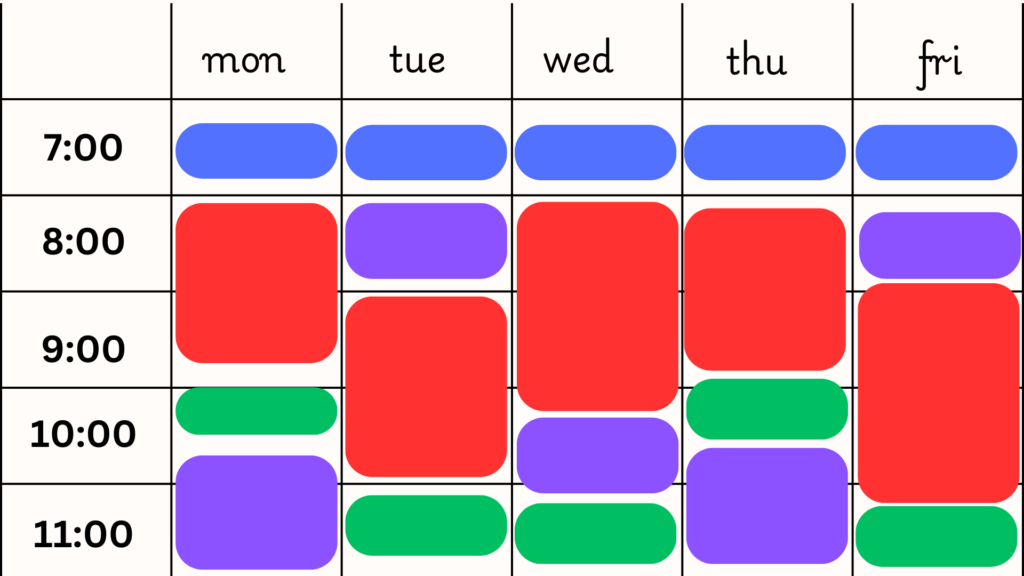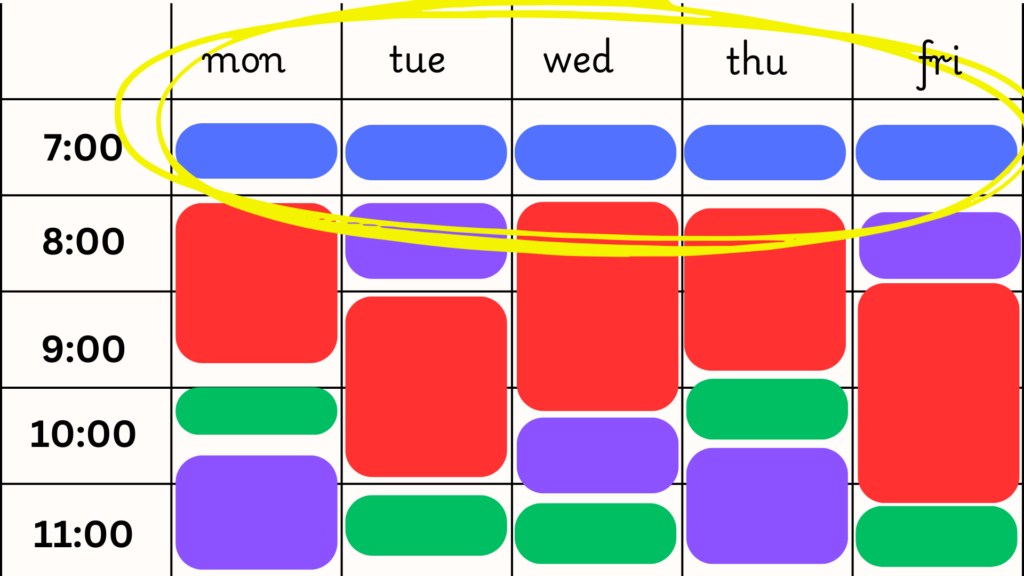time blocking method for students: step-by step guide.
You know that feeling when the day just slips through your fingers? You wake up with every intention to finish your assignments, prep for your test, and maybe even squeeze in some Netflix time—but somehow, it’s midnight, and you’ve barely scratched the surface.
Yeah, we’ve all been there.
But here’s the thing: your time isn’t running away from you—you’re just not telling it where to go. That’s where the time blocking method for students comes in. It’s not about filling every second of your day with work; it’s about being intentional, so you can actually get things done and still have time for what you love. So lets get into it.
What Is the Time Blocking Method?
Time blocking is a scheduling technique where you break your day into focused, pre-planned blocks of time dedicated to specific tasks or activities. Unlike traditional to-do lists, time blocking forces you to think about when you’ll complete each task, adding structure and intentionality to your day.
Imagine a puzzle where every piece (or hour) fits perfectly—it’s satisfying and efficient!
Why Students Need Time Blocking
You might wonder, Why should I bother planning every minute? Here’s why the time blocking method can transform your student life:
- It’s a Procrastination Killer
When you schedule tasks, there’s less room for excuses like “I’ll do it later.” - It Prioritizes What Matters
With time blocking, you allocate time to crucial tasks before distractions take over. - Boosts Focus and Productivity
Say goodbye to multitasking! Each block is for one task only. - Prevents Overwhelm
Seeing your day laid out in manageable chunks reduces anxiety.
How to Implement the Time Blocking Method for students.
Let’s break it down step by step:
Step 1: Assess Your Current Schedule
- List all your daily and weekly commitments (classes, extracurriculars, commute, meals).
- Identify free blocks of time for self-study or leisure.
Step 2: Set Clear Goals
- Determine your priorities: What subjects or projects need the most attention?
- Define SMART goals for each study session (e.g., complete three chemistry problems).
Step 3: Create Your Block Categories
- Use tools like Google Calendar, Notion, or a physical planner.
- Colour-code blocks for different activities (e.g., green for breaks, red for study).
- 🔴 Intense Study
- 🟢 Breaks
- 🔵 morning prep
- 🟣 Flexible Time
Step 4: Incorporate Breaks and Flexibility
- Follow the Pomodoro technique: 25 minutes of focus followed by a 5-minute break.
- Add buffer time between blocks to transition smoothly.
Step 5: Review and Adjust Weekly
- Reflect on what worked and tweak your schedule accordingly.
Time Blocking vs. Time Boxing
Time Boxing is a complementary technique where you assign a strict time limit to a task, no matter how far you get. It’s ideal for perfectionists who might otherwise spend too much time on one task.
Example:
Block 45 minutes to write the first draft of your essay. When the time is up, move on, even if the draft isn’t perfect.
Benefits:
- Prevents overworking on low-priority tasks.
- Encourages faster decision-making and action.
Time Batching: Grouping Similar Tasks
Time batching involves grouping similar tasks together to minimize context switching and save mental energy.
Example: Instead of replying to emails throughout the day, batch them into a single time block (e.g., 5 PM – 5:30 PM).
How Students Can Use It:
- Batch note-taking or outlining assignments in one session.
- Dedicate one time block for all social media or phone notifications.
Benefits of Time Blocking
Why should students embrace this method? Here are the top benefits:
- Enhanced Focus and Productivity
Allocating specific blocks for tasks reduces multitasking and improves concentration. - Better Time Awareness
Time blocking teaches you to value and track your time, helping you identify time-wasting habits. - Reduced Procrastination
Knowing you have a set time for every activity leaves less room for delay. - Improved Work-Life Balance
By scheduling downtime, you avoid burnout and make time for hobbies and relaxation. - Achievement of Goals
When tasks are systematically planned, you’re more likely to achieve your academic and personal goals.
Example Time-Blocking Schedule for Students
Here’s a sample schedule to inspire you:
| Time | Activity | Details |
|---|---|---|
| 7:00 – 7:30 AM | Morning Routine | Meditation, light breakfast |
| 7:30 – 8:30 AM | Class (History) | Lecture and note-taking |
| 8:30 – 9:00 AM | Break | Check emails, quick walk |
| 9:00 – 11:00 AM | Study Session | Math problem-solving |
| 11:00 – 12:00 PM | Group Project | Collaborate on research assignments |
| 12:00 – 1:00 PM | Lunch and Socializing | Recharge with friends |
| 1:00 – 3:00 PM | Test Preparation | Focus on weak topics (e.g., Chemistry) |
of course this wouldn’t apply to everyone, so just use what works best for you.
Tips for Staying Consistent
- Start Small
Begin by blocking time for two or three tasks daily before scaling up. - Stay Realistic
Avoid overloading your schedule. Leave room for unexpected events. - Track Progress
Use habit-tracking apps or journals to monitor your consistency. - Embrace Imperfection
It’s okay to adjust blocks or miss a task occasionally—progress matters more than perfection.
Conclusion
The time blocking method for students isn’t just a productivity hack; it’s a game-changer. By assigning purpose to your hours, you can stay organized, achieve goals, and enjoy life beyond academics. hope you found this helpful i encourage you to experiment with this and use this new found skill to its full potential, happy studying.






